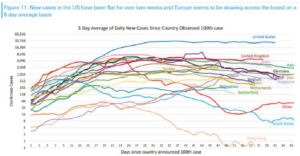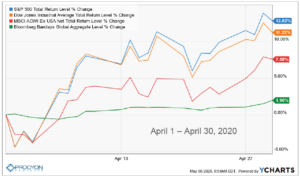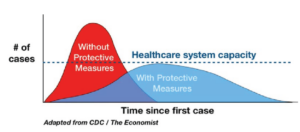“…the fear does not subside, and we are expected to move against the fear. One must choose to do it afraid.”
— Elisabeth Elliot
Intro
We have all become keenly aware that the true depth of the economic impact on the global economy may ultimately be determined by how long COVID-19 remains a significant health threat. This is the reality that is shaping our present and will have lasting impact on the roles of all members within society, industry, and governments. However, as we read MS Elliot’s words, we believe that we need to adapt, and adapt we will.
The Procyon Investment Committee has been meeting with increased frequency the last few months to understand, act and communicate our views. In this commentary we outline some of the themes we have observed and acted on over the last several weeks as markets reversed course and risk taking a deeper dive into the political implications.

Health
As of this publication global cases rose to over 3.7 million cases. In the US, cases rose at 2% below the 5- day average of 2.4% but about the same rate as 2 weeks ago. Cases have increased in Russia, Brazil and Africa while remaining under 1% in major European countries such as Italy, France, and Germany. It appears that the US has indeed been successful in flattening the curve as we laid out in our base case scenario a month ago. In the US, the percent of the population under stay at home orders rose to 90% for most of April and has recently begun to lessen as each state governor makes risk-based decisions on when and how much to reopen. In our view it is not a binary decision—100% stay at home so there are no new cases, but you devastate the state economy. Or conversely 100% remain open with no risk mitigation efforts. It is likely social distancing will remain for an extended period and higher risk groups will continue more protective measures for longer. We find it ironic some news sources are reporting “new infections” in reopening areas as “proof” it is not working or that new deaths are someone’s fault. They forget the original purpose of the flatten the curve contagion strategy. Without a vaccine there was never going to be no new infections. Instead the goal was to slow the rate of new infections to keep the number of cases below the capacity that the health care system can handle. We are at the flattening point now but if you look at the ubiquitous graph below you will notice the long and fat tail to the right of the peak. Meaning we will have new cases for a long time, and they are not insignificant—approximately the same amount we have already experienced. We are perhaps about 50% of the way through this. This obviously has direct economic implications.
April Market Summary
But let us step back from the ever present and at times overwhelming health care news and review some good news—the recent market performance. In March we witnessed a continuation of the historic market selloff, but April showed a remarkable recovery in asset prices.
The largest US companies (S&P 500) returned 12.82% for the month, led by the giant tech companies in that index including Microsoft, Apple, Amazon and Google. This dramatic rebound off the March 23rd lows, represents an approximate retracement of more than 50% of the drop the previous two months. At the end of April, the 2020 year- to-date return for the S&P 500 was -9.29%. While there is a wide range in earnings estimates today, the current valuation for the S&P 500 is close to short-run historic averages for both 2020 and 2021. Somewhat less positive is that the index returns may be a bit unsustainable with a few large companies dominating recent gains while more than two-thirds of S&P 500 companies performing below the index average.
US Small Cap equities (Russell 2000) saw a strong rebound in April up 13.74% as investors dipped their toe back into riskier stocks. At the March lows, small cap equities were down – 39.73% as investors broadly sold their riskier assets as the COVID impact weighed on markets. The Russell 2000 Index continues to materially trail large cap equities year to date, down almost twice as much at -21.08%.
International stock markets, represented by MSCI ACWI ex-US (All Country World Index) were up but not as much, returning 7.58% for the month and -17.55% for 2020. China (MSCI China) and broad emerging markets (MSCI Emerging Markets ex-China) saw a reversal with emerging markets outperforming China for the month of April with returns of 9.16% and 6.32% respectively. Through the end of April, year-to-date China has returned -4.54% with emerging markets returning -16.60%.
Bond markets also continued their rally through April as the Central Bank took swift and sweeping action to ensure ample liquidity in the markets. The Bloomberg Barclays Global Aggregate Bond Index, which represents fixed income around the world, had a positive return for the month of 1.96%, bringing the year-to-date return to 1.63%. In the US, the Barclays US Aggregate Bond Index returned 1.78%, with a year-to- date return of 4.98%. The municipal bond market did not fare as well down -1.26% for April as loss of revenue and increased costs to mitigate the effects of the pandemic weighed on the bonds issued by cities and states.

We firmly believe that society will adapt over the medium and long-term, and as Liz Anne Sonders of Charles Schwab recently suggested
“…we are likely transitioning to an economy that will be less dependent on consumers, and more dependent on investments—from housing to manufacturing; from low tech to high tech; from offshoring to onshoring; and health care of course”
We may be seeing the beginning of a generational change that in large part may be shaped by our government’s response.
Political Implications
Our investment committee cannot ignore the increasing role politicians of all stripes are playing in the economy. As we hypothesize about new business models and winners and losers in the COVID economy we need to be cognizant of the politics. While we have clients across the entire political spectrum, we try to limit our analysis to expected economic implications of the possible outcomes.
Our elected officials passed the first four relief bills with minimal political wrangling. That will probably not remain the case as we progress, but we do see possibilities for a fifth relief bill focused on some combination of aid to cities and states, hazard pay to front line workers, more direct aid to impacted individuals, and infrastructure spending. It could include tweaks to current tax law involving the SALT cap, FICA payroll deductions, capital gains rate, or allowing companies to fully expense meals and entertainment to support the restaurant industry. Some or none of these may come to pass depending on the climate in Washington and the progress of the economy.
Benefitting small businesses, the President and Congress have twice funded the Paycheck Protection Program, and we expect the continued and improving operation of that program to be critical for small business owners and the communities they serve.
In the November Presidential election, we believe the virus and the reaction to it has now supplanted all other issues. What the “swayable voters” in a few battleground states decide will determine the outcome of the presidential election. How will they assign responsibility or blame between the President and the governors? How will the reopening go state by state? How do the campaigns unfold in a time of COVID? We do not know the answer to those important political questions.
We currently expect control of both houses of Congress to remain unchanged. In the house only 23 of the districts are truly competitive and the Democrats must keep six of the 23 to maintain control. Unless we have a “wave” election the power of incumbents will maintain their position. Conversely, in the Senate the Republicans are currently 53-47 but will almost certainly regain the seat in Alabama so it will be effectively 54-46. The Democrats would need to win 4 or 5 to gain control of the Senate depending on the outcome of the Presidency.
They currently have a chance in CO, AZ, ME and NC but would need to be successful in all those states. Republicans also have a chance at a couple of new seats, but it is a tougher challenge. And do not forget the control of State Houses where Democrats are currently in the ascendancy now controlling 23 up from 17. This will have ramifications for the next decade as state houses gerrymander Congressional districts following the 2020 Census. So politically there is a lot to “discuss” with your friends and family during the quarantine!
More broadly the tension between states’ rights and federal power has been an important discussion for our society since its founding and there should be no surprise that the conversation continues. We also see increasing tension between the conflicting concepts of personal privacy and the desire for more virus tracking on cell phones and the like.
So where does that leave us? Working through the reopening process–state by state and watching the data to see how progress is being made on both the medical and economic fronts. The financial markets will also be watching and, as we have stressed before, reacting to what they anticipate will be happening six months from now. April was a great example of that with the best financial performance in decades while simultaneously the economic news was conversely the worst in decades. It’s not bad or good—the question the markets ask is “is it getting “less bad” than it was”?
We expect to see several different reopening processes coming in waves accompanied by the potential flare up of a hot spot for COVID-19.
There seem to be two camps: We will go back to the way things were (although that camp is shrinking) and this is the “new normal”, where we wear masks and constantly sanitize. While we are all playing that guessing game it is most probable that our adaption is a combination. Like many times before this, large scale global events have touched almost every life on earth much like WWII and the Great Depression. We will certainly change, grow and adapt.
“The measure of intelligence is the ability to change.”
